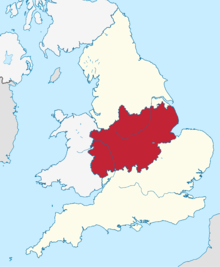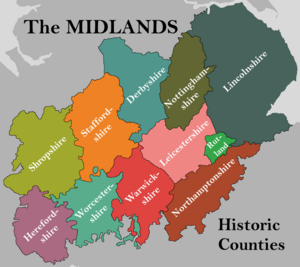The Midlands | |
|---|---|
 The Midlands region shown in England | |
| Sovereign state | |
| Constituent country | |
| Major cities | Birmingham Coventry Derby Leicester Lincoln Nottingham Stoke Wolverhampton Worcester |
| Principal settlements | A 'Metro' cities B Other 'cities'
|
| Area | |
| • Total | 28,627 km2 (11,053 sq mi) |
| Highest elevation | 703.6 m (2,308 ft) |
| Population (2021 census) | |
| • Total | 10,831,000 |
| • Density | 380/km2 (980/sq mi) |
| Demonym(s) | Midlander, Mercian |
| Time zone | UTC+0 (Greenwich Mean Time) |
| • Summer (DST) | UTC+1 (British Summer Time) |
The Midlands is the central part of England, bordered by Wales, Northern England, Southern England and the North Sea. The Midlands correspond broadly to the early-medieval kingdom of Mercia, and later became important in the Industrial Revolution of the 18th and 19th centuries. They are now split into two official regions, the West Midlands and East Midlands. The Midlands' biggest city, Birmingham, is the second-largest in the United Kingdom. Other important cities include Coventry, Derby, Leicester, Lincoln, Nottingham, Stoke-on-Trent, Wolverhampton, and Worcester.
A saltire (diagonal cross) may have been used as a symbol of Mercia as early as the reign of Offa.[1][better source needed] By the 13th century, the saltire had become the attributed arms of the Kingdom of Mercia.[2] The arms are blazoned Azure, a saltire Or, meaning a gold (or yellow) saltire on a blue field. The saltire is used as both a flag and a coat of arms. As a flag, it is flown from Tamworth Castle, the ancient seat of the Mercian kings.[1]

The flag also appears on street signs welcoming people to Tamworth, the "ancient capital of Mercia". It was also flown outside Birmingham Council House during 2009 while the Staffordshire Hoard was on display in the city before being taken to the British Museum in London. The cross has been incorporated into a number of coats of arms of Midlands towns, including Tamworth, Leek and Blaby. It was recognised as the Mercian flag by the Flag Institute in 2014.[4]
There is no single definition for the Midlands. If defined as being made up of the statistical regions of East Midlands and West Midlands,[5] it includes the counties of Derbyshire, Herefordshire, Leicestershire, most of Lincolnshire (with the exception of North and North East Lincolnshire), Northamptonshire, Nottinghamshire, Rutland, Shropshire, Staffordshire, Warwickshire, Worcestershire and the West Midlands metropolitan boroughs.
Other definitions include a slightly larger area and the 1911 Encyclopædia Britannica, describes Gloucestershire as "West Midland", Bedfordshire as "South Midland", and Huntingdonshire as "East Midland" counties respectively. Cheshire is also occasionally recognised as being in the Midlands, while a lot of what was historically part of southern Mercia (Gloucestershire, Oxfordshire, Buckinghamshire, Bedfordshire, Hertfordshire, Huntingdonshire, and Cambridgeshire) is often labelled as "Central England", typically used interchangeably with "the Midlands".
Additionally, there are two informal regions known as the South Midlands and North Midlands, which are not NUTS statistical regions of the United Kingdom and their definition varies by using organisation. The former includes the southern parts of the East Midlands and northern parts of Southern England.[6] The latter covers the northern parts of the West and East Midlands, along with some southern parts of Northern England.[7][8][9]
The West Midlands and East Midlands regions are NUTS 1 statistical regions and were formerly constituencies of the European Parliament. Local government in the Midlands is as follows:

The unitary authorities of North Lincolnshire and North East Lincolnshire (not shown), while classed as part of the ceremonial county of Lincolnshire, actually come under the Yorkshire and the Humber region and are therefore not in the officially recognised East Midlands region.
The two regions of the Midlands have a combined population of 10,350,697 (2014 mid-year estimate),[10] and an area of 11,053 sq mi (28,630 km2).
The largest Midlands conurbation, which includes the cities of Birmingham and Wolverhampton, is roughly covered by the metropolitan county of the West Midlands (which also includes the city of Coventry); with the related City Region extending into neighbouring areas of Shropshire, Staffordshire, Warwickshire and Worcestershire.
Various parts of the Midlands, particularly Warwickshire and Leicestershire, are on occasion referred to as the Heart of England, especially in tourist literature given that the geographic centre of England is generally considered to lie within this arc.
Different areas of the Midlands have their own distinctive character, giving rise to many local history and industrial heritage groups. Nottingham played a notable part in the English Civil War, which is commemorated in a number of place names (Parliament Terrace, Parliament Street, Standard Hill). Areas such as Derbyshire's Amber Valley and Erewash combine attractive countryside with industrial heritage and are home to historic canals and sites associated with the mining industry. The Black Country, broadly the boroughs of Dudley, Sandwell, Wolverhampton and Walsall, played an important part in the Industrial Revolution.[citation needed]
|
Main article: Historic counties of England |

The historic counties ceased to be used for any administrative purpose in 1899 but remain important to some people, notably for county cricket.
The area is predominantly low-lying and flat apart from isolated hills such as Turners Hill within the Black Country conurbation at 271 m (889 ft) and the Wrekin just south of Wellington in Telford at 407 m (1,335 ft). Upland areas lie in the west and north of the region with the Shropshire Hills to the west, close to the England–Wales border and the Peak District area of the southern Pennines in the north of the region. The Shropshire Hills reach a height of 540 m (1,771 ft) at Brown Clee Hill and includes the Long Mynd, Clee Hills and Stiperstones ridge. Wenlock Edge, running through the middle of the Shropshire Hills Area of Outstanding Natural Beauty (AONB), is a long, low ridge, which extends for over 15 miles (24 km).[11] The Peak District reaches heights of between 300 m (1,000 ft) and 600 m (2,000 ft); Kinder Scout is the highest point at 636 m (2,086 ft).[12] Further south, the Welsh border reaches over 700 m (2,000 ft) high, at Twyn Llech (Black Mountain), which at 703 m (2,306 ft) is thus the highest point in Herefordshire.
The Precambrian Malverns are formed of some of the oldest rock in England (dating from the Cryogenian period, at around 680 million years old) and extend for 8 miles (13 km) through two West Midlands counties (Worcestershire and Herefordshire) as well as northern Gloucestershire in the southwest. The highest point of the hills is the Worcestershire Beacon at 425 m (1,394 ft) above sea level (OS Grid reference SO768452).[13][14]
The Cotswolds – designated an AONB in 1966.[15] – extend for over 90 miles (140 km) through Oxfordshire, Gloucestershire, Wiltshire, Somerset, Warwickshire, and Worcestershire. They reach a highest point of 330 m (1,082 ft) at Cleeve Hill.
Areas of lower hills, in the range 200 m (600 ft) - 300 m (1000 ft), include Charnwood Forest in Leicestershire, Cannock Chase in Staffordshire, and the Lincolnshire Wolds (100 m (300 ft) - 200 m (600 ft)); the latter having some prominence despite their modest altitude given their location in typically low-lying Lincolnshire near to the east coast.
Lincolnshire is the only coastal county in the Midlands as the region is bordered by Wales to the west. It is also where the Midlands' lowest points can be found as some places fall below sea level, with the lowest points being near Thorpe Tilney in North Kesteven and Stickford in East Lindsey.[16]
The Midlands has a temperate maritime climate, with cold, cloudy, wet winters and comfortable, mostly dry, mostly sunny summers.[17] The temperature usually ranges from −0.4 °C (31.3 °F) during winter nights to 24.1 °C (75.4 °F) during summer days. Due to its geographical location, which is furthest away from the coast than anywhere else in England, it typically receives mostly light winds, with warm days and cold nights. Sometimes the Midlands can have very cold nights such as a minimum of −18.7 °C (−1.7 °F) in Pershore on 20 December 2010. The previous day had a maximum of only −8.2 °C (17.2 °F), also in Pershore. Hot days are also possible, such as a maximum of 34 °C (93 °F) in Pershore on 19 July 2006. There can also be very mild winters nights, such as in Bidford-on-Avon when the temperature at 6 pm was as high as 15.2 °C (59.4 °F) on 9 January 2015. At 8 am the following morning the temperature was still at 13 °C (55 °F).[18][19][20] Both the highest and lowest temperature ever recorded in England were in the Midlands, the former on 19 July 2022 around Coningsby in Lincolnshire where it reached a maximum temperature of 40.3 °C (104.5 °F),[21] and the latter on 10 January 1982 around Newport in Shropshire where it dropped to a minimum of −26.1 °C (−15.0 °F).
| Climate data for Midlands | |||||||||||||
|---|---|---|---|---|---|---|---|---|---|---|---|---|---|
| Month | Jan | Feb | Mar | Apr | May | Jun | Jul | Aug | Sep | Oct | Nov | Dec | Year |
| Mean daily maximum °C (°F) | 6.7 (44.1) |
7 (45) |
9.7 (49.5) |
12.5 (54.5) |
15.9 (60.6) |
18.8 (65.8) |
21.1 (70.0) |
20.8 (69.4) |
17.8 (64.0) |
13.7 (56.7) |
9.6 (49.3) |
6.9 (44.4) |
13.4 (56.1) |
| Mean daily minimum °C (°F) | 1 (34) |
0.8 (33.4) |
2.4 (36.3) |
3.7 (38.7) |
6.5 (43.7) |
9.4 (48.9) |
11.5 (52.7) |
11.3 (52.3) |
9.3 (48.7) |
6.5 (43.7) |
3.5 (38.3) |
1.3 (34.3) |
5.6 (42.1) |
| Average rainfall mm (inches) | 74 (2.9) |
54 (2.1) |
58.8 (2.31) |
59.1 (2.33) |
58.5 (2.30) |
62.3 (2.45) |
60.8 (2.39) |
66.9 (2.63) |
66.2 (2.61) |
82 (3.2) |
77.1 (3.04) |
78.7 (3.10) |
798.4 (31.36) |
| Average rainy days (≥ 1 mm) | 12.9 | 10.2 | 11.5 | 10.6 | 10.2 | 9.7 | 9.4 | 10 | 9.7 | 12.2 | 12.5 | 12.4 | 131.3 |
| Mean monthly sunshine hours | 52.1 | 71.4 | 104.8 | 147 | 183.2 | 174.7 | 189.6 | 177.6 | 132.2 | 99.4 | 61.2 | 45 | 1,438.2 |
| Source: Met Office[22] | |||||||||||||
The "midland" name has been used for: